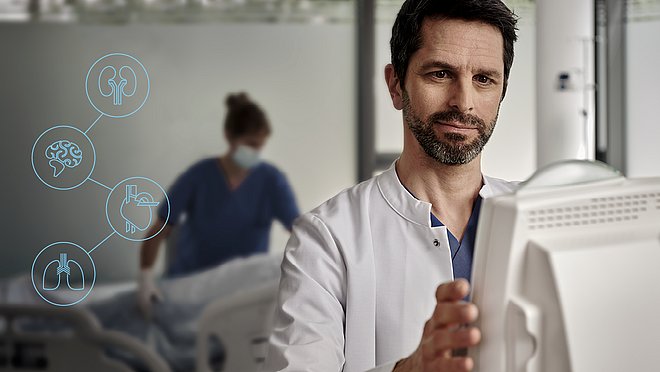Offering renal care and beyond.
Heart and lung support
ECMO treatment for pulmonary and cardiac failure
Heart and lung support describes our treatments for patients suffering from pulmonary and/or cardiac failure. Based on one single platform that combines heart and lung support, we offer various treatment options. These are all based on the principle of extracorporeal membrane oxygenation (ECMO).
ECMO is a type of extracorporeal life support (ECLS) that provides cardiopulmonary support to critically ill patients when conventional treatments have failed.
ECMO can be performed using veno-venous cannulation for primarily respiratory support or veno-arterial cannulation for cardiocirculatory or cardiopulmonary support.
Patients who require ECMO typically suffer from cardiac and/or respiratory failure due to underlying conditions such as cardiogenic shock, acute respiratory distress syndrome, or congenital defects.
During extracorporeal support, the venous blood is drained, decarboxylated, oxygenated, warmed, and infused back into the circulation. The goals of ECMO include optimizing patient physiology and improving outcomes in severe respiratory or cardiac failure. ECMO supplies tissue oxygenation, removes CO2, allows the lung and heart to rest, and stabilizes the cardiovascular system.1
Veno-venous ECMO (VV ECMO)
- Improves systemic oxygenation
- Drains blood from a major vein and returns it to a major vein
- The native cardiac output provides adequate circulation
Veno-arterial ECMO (VA ECMO)
- Supports heart and lung (circulatory and respiratory functions)
- Drains blood from a major vein and returns it to a major artery
Related content
1 Sangalli, F., Patroniti, N., & Pesenti, A. (Eds.). (2014). Ecmo-Extracorporeal Life Support in Adults. Springer Milan. doi.org/10.1007/978-88-470-5427-1
2 Brogan TV et al. Extracorporeal Life Support: The ELSO Red Book (5th edition) 2017






